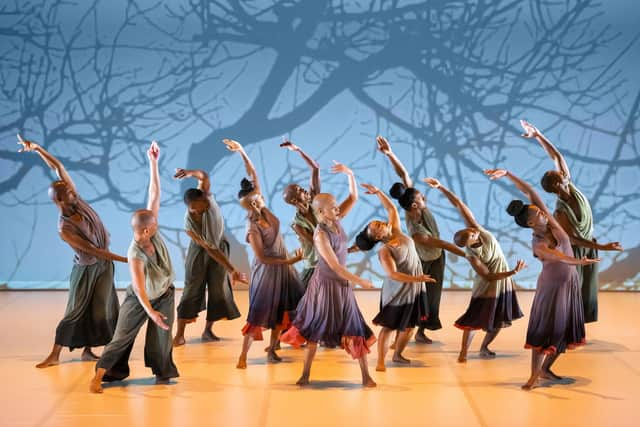Review: Dada Masilo in Brighton - "And the lights fade to a standing ovation and extended applause"
and live on Freeview channel 276
Dada Masilo's "The Sacrifice", presented by the Dance Consortium, premiered its round-Britain tour at The Brighton Dome last Tuesday,
Masilo is a talented 38-year-old South African dancer and choreographer, known for her reworking of classic stories to reflect her black identity. She has a reputation for reimagining classical ballets: (Giselle, Romeo & Juliet), and was inspired by the music from Igor Stravinsky's Rite of Spring for this ballet.
Advertisement
Hide AdAdvertisement
Hide AdThe story is about the return of Spring and the renewal of the earth through the sacrifice of a young woman - or maiden, chosen by her community to dance herself to death. Dada herself plays the rôle of the maiden. "I wanted to create a work that would move people".


The Covid pandemic changed the concept and the work became about healing, because some members of the company lost loved ones. "I wanted to embrace the grief and help it heal. We have a saying that goes 'mother earth, community, the Universe'. The Community are the people that help to make the sacrifice anyway ".
The stopping and starting in production work became frustrating but it came together for the performance we saw last Tuesday. Nothing short of extraordinary.
Dada uses the music to create an unusual dance routine. It's a different form - rhythms are jerky, fast, surprising. Dada learned the style from her own heritage but the complex unpredictable rhythms of the Tswana dance reminded her of Stravinsky's music. In a sense it imitates meerkat dancing.
Advertisement
Hide AdAdvertisement
Hide AdDada - the maiden - was chosen by her community to dance herself to death. She fights against this journey, until it happens that her own mother is chosen to sacrifice her.
So the dancers, all dressed in loose grey costumes, opened the show, against the backdrop of a large leafless Acacia tree. They performed with synchronised rhythmical movements to Stravinsky's music, using expressive arm movements and shuffling and stomping of the legs, including strange bends and stretches.
Dada, bare chested, comes on. She seems sad. Mama (Powerful singer Ann Masina) begins to sing "Mielies" - corn on the cob. A common sound of African women selling a staple food in Africa. She crosses the stage and joins the musicians at Stage Right - keyboard, violin and the percussionist who creates bizarre sounds with assorted props. Keyboard player Nathi Shongwe, percussionist Mpho Mothiba, violinist Leroy Mapholo and the powerful voice of Ann Masina. Their musical insertions prompted the dancers in their movements. The percussion section included bizarre effects of gratings, drummings, shakings and a rotating rope-like cord making surreal sounds, and that had apparently been cut from a washing machine hose!
Hard to describe because there's never been anything like it. Occasionally a clap, a fall, a catch, Dada Masilo the principle dancer and, as with many of the troupe, her head is shaved. Vocal intonations, screams, stamps. Atmospheric musical interludes. Dancers' skirts showing flashes of red.
Advertisement
Hide AdAdvertisement
Hide AdLuckily my South African friend came with me. She understood much of the language, the nuances and the culture. She explained about the woman speaking in Zulu, telling her story, lying prostrate and crying. 'Jehovah' - God. 'Lutho' - nothing. The band joins in with keyboard, drums, violin and low vocals. The woman is writhing, appearing possessed, her body out of control as though something is pulling her. "Kwenzenjani - what are you doing?" Other dancers mirror her moves, the tone is lamenting, sad and forlorn, Three dancers are left on stage: "Ngyaphuza - I drink".
Then we see the other bare chested dancers, wearing loose white bottoms. Dada joins them and approaches a woman who offers her a lily, which she silently accepts.
Happy tribal music ensues. The two dancers, male and female, join the whole group and in a celebratory mood say "Come back - Shabuya". There was beauty in their bare chested movements; It was not offensive. Being bare chested is about culture and tradition; about respect and the fact that she's a maiden and a virgin.
A man dressed in white rejoins the dance while a rattlesnake sound is made by the shaker. They dance together in perfect sync; he touches her for the first time and, as he lifts her, she falls trustingly into his arms.
Advertisement
Hide AdAdvertisement
Hide AdHer time has come. Three other men in white join them on stage; they dance around her ominously; moving from one to the other; they throw her down; a bird-sounding instrument echoes her crying, and the four men gather her up and raise her horizontally as if in a funeral procession.
At a given moment, singer Ann Masina leaves her perch alongside the orchestra, to appear on stage. As Dada's mother, she takes the lifeless form safely in her arms, comforting her. She finally covers Dada's eyes and places her lifeless body on the floor, performing the sacrifice. Mama is singing, almost groaning, accompanied by violin and drums. The ten bare chested dancers join, clutching lilies and bowing to Dada. As Mama sings her dirge, she clutches her clothes in anguish.
And the lights fade, to a standing ovation and extended applause.